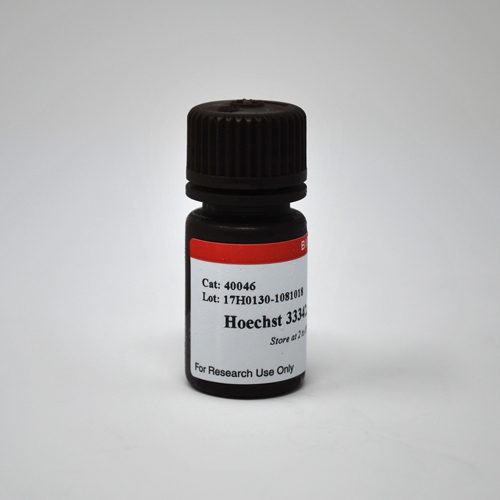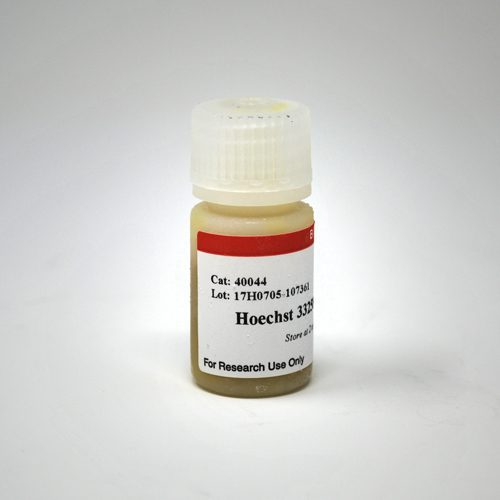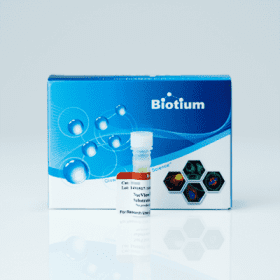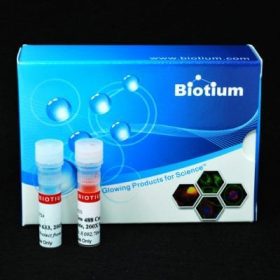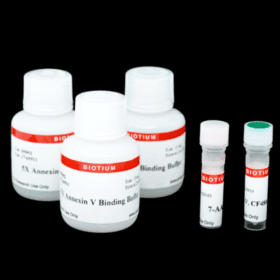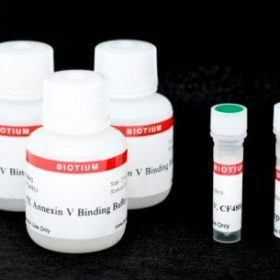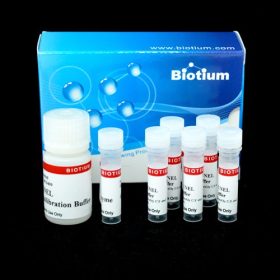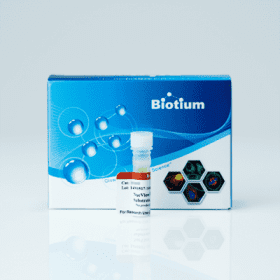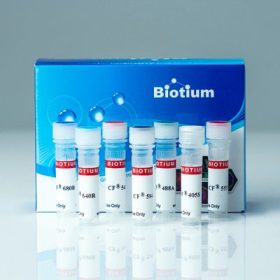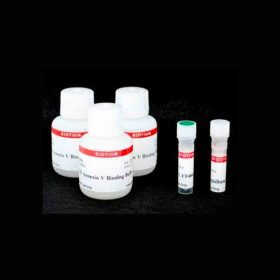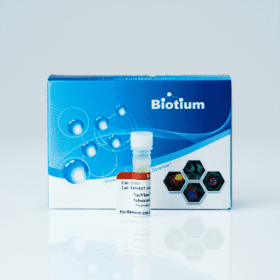Biotium products are distributed only in Singapore and Thailand.
Thiazole orange homodimer (TOhD), also know as TOTO®-1, is a cell-impermeant, high-affinity, fluorogenic green nucleic acid stain.
| SIZE |
CATALOG #
|
PRICE
|
| 10 mL | #40017 |
$44 |
|
2 mL |
#40048 |
$65 |
| 100 mg | #40016 |
$74 |
PRODUCT ATTRIBUTES
| Cellular localization |
Nucleus & cytoplasm |
|---|---|
| Detection method/readout |
Fluorescence microscopy, Flow cytometry |
| Assay type/options |
DNA content/cell cycle (flow cytometry), No-wash staining, Real-time imaging |
| Cell permeability |
Membrane impermeant |
| Apoptosis/viability marker |
Dead cell stain |
| Colors |
Red |
| Excitation/Emission |
493/636 nm (without DNA), 535/617 nm (with DNA) |
| Storage Conditions |
Store at 2 to 8 °C, Protect from light |
| CAS number |
25535-16-4 |
| Molecular weight |
668.4 |
PRODUCT DESCRIPTION
Propidium iodide (PI) is a cell impermeable nucleic acid intercalating dye. Because PI is excluded from viable cells, it often used to selectively stain dead cells in a mixed live-dead cell population. PI is often used as a counterstain in multicolor fluorescence applications.
- Red fluorescent nucleic acid stain
- Fluorescence increases 20- to 30-fold when bound to nucleic acids
- Dead cell specific in all cell types, including mammalian cells, bacteria, and yeast
- Compatible with flow cytometry and fluorescence microscopy
Propidium Iodide (PI) Products
| Propidium Iodide Products | Catalog Number | Unit Size | Format |
|---|---|---|---|
| Propidium Iodide | 40016 | 100 mg | Orange red solid |
| Propidium Iodide, 1 mg/mL in Water | 40017 | 10 mL | Orange/red solution |
| Propidium Iodide, 50 ug/ml in Buffer | 40048 | 2 mL | Orange/red solution |
After entering cells and binding to DNA and RNA, the fluorescence of PI is enhanced 20- to 30-fold. PI can be used in flow cytometry and fluorescence microscopy. PI is also utilized as a counterstain in multicolor fluorescent imaging, but nuclear-specific staining requires digestion of cellular RNA.
Find the Right Stain for Your Application
PI is dead cell specific in all cell types, including mammalian cells, bacteria and yeast. PI can be used to distinguish necrotic or late apoptotic cells with damaged plasma membranes from viable cells or early apoptotic cells with intact cell membranes. Ethidium Homodimer I is the most common alternative to PI; the high affinity of EthD-I permits the use of a lower dye concentration and no-wash staining. Biotium developed Ethidium Homodimer III, as a superior alternative to EthD-I. The absorption and emission spectra are similar, but EthD-III is 45% brighter. Biotium also offers other dead-cell stains in other colors and with other beneficial properties such as Live-or-Dye NucFix™ Red which, unlike PI, is a fixable dead-cell stain. See our Cellular Stains Selection Guide and Cellular Stains Table for more information. Learn more about PI and other dead-cell specific stains.
Biotium also offers other live-cell specific stains in other colors and with other beneficial properties. Such as NucSpot® Live Cell Nuclear Stains, which are cell-membrane permeable DNA dyes that specifically stain nuclei in live or fixed cells. They have excellent specificity for DNA without the need for a wash step, and they have low toxicity for live cell imaging.
Cell Viability & Apoptosis Assays
Biotium offers a wide-selection of assay kits for cell viability and cell death for microplate reader, flow cytometry, or fluorescence microscopy. PI and CF®488A-Annexin V are available as a convenient kit for staining apoptotic cells with green fluorescence and necrotic cells with red fluorescence. Ethd-III component of several combination viability assay kits for detecting both live and dead cells in the same population, such as our Viability/Cytotoxicity Assay Kit for Animal Cells and our Viability/Cytotoxicity Assay Kit for Bacteria. Learn more about our Cell Viability & Apoptosis Assays.
Reference Publications
Arvizu, Ignacio Servando, and Sean Richard Murray A simple, quantitative assay for the detection of viable but non-culturable (VBNC) bacteria STAR protocols vol. 2,3 100738. DOI: 10.1016/j.xpro.2021.100738 Article Snippet: “Propidium iodide and SYTO 9 (Molecular Probes) and DMAO and EthD-III (Biotium) stains are known to bind nucleic acids. Wear personal protective equipment as they are potential mutagens.” Mikhail Guzaev, Xue Li, Candice Park, Wai-Yee Leung, and Lori Roberts Comparison of Nucleic Acid Gel Stains Cell permeability, safety, and sensitivity of ethidium bromide alternatives Biotium, Inc., Fremont, CA DOI: www.biotium.com Article Snippet: “DAPI (catalog no. 40011), propidium iodide (catalog no. 40016), and acridine orange (catalog no.40039) from Biotium were used as reference dyes.” Haishan Shi, Xiaoling Ye, Jing Zhang, and Jiandong Ye Enhanced Osteogenesis of Injectable Calcium Phosphate Bone Cement Mediated by Loading Chondroitin Sulfate ACS Biomaterials Science & Engineering 2019 5 (1), 262-271 DOI: https://doi.org/10.1021/acsbiomaterials.8b00871 Article Snippet: “After being cultured for 1 and 3 days, cells were rinsed with PBS thrice, and double-stained with Calcein-AM (Viability Assay Kit for Animal Live Cells, Biotium, USA) and propidium iodide (PI;Biotium, USA) according to the instructions.”


